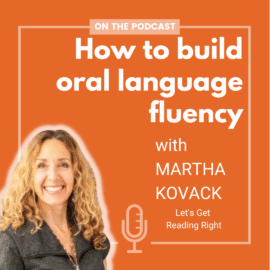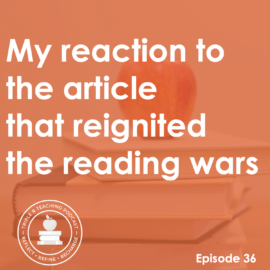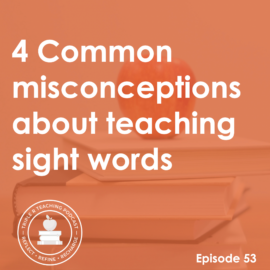
TRT Podcast#52: Science of Reading Q & A: #2
What should you do with all your leveled books? Is there any place for them in a science of reading classroom? What should you do when students just can’t master their short vowel sounds? When do you move on? And what about assessing struggling readers? Should you use Fountas & Pinnell’s benchmark assessment to find their reading level? Get answers to these questions and more in this science of reading Q & A episode!
Listen to the episode here
Full episode transcript
Hello, and welcome to our second Science of Reading Q & A! In our last episode, I answered some questions that some listeners had after I gave an online workshop with my colleague, Becky Spence. These are also questions that were submitted to a survey.
My first question was from someone who runs a small village school in India. They're teaching English as a second language and the students are really struggling with short vowel sounds. They asked, "At what point do you just say that's good enough and move on so they can continue to make progress, because they're really struggling to distinguish between the short vowel sounds."
One thing I recommend doing as you're teaching those vowel sounds is to teach some kind of visual cue for each vowel sound. So /a/, you might have your hand making the shape of an apple: /ă/, apple. Or you could have an apple that you're about to eat, /ă/. And then for /ĕ/, maybe you'll have your fingers on the side of your mouth. For /ĭ/, you might be itchy in your shoulder. /ŏ/ you might have your finger on your chin as your mouth is open very tall: /ŏ/. For /ŭ/, you might have a fist on your stomach: /ŭ/.
I think it's really good to have these consistent motions that you make when you teach those short vowel sounds. So find something that you think is really going to work for your students and use those motions as you have students practice the sounds.
At the beginning of each of your lessons, I would have flashcards that have those short vowel letters and you have them practice the sound. So if you have a "U," for example, they would say, "U says /ŭ/." And then when they say the /ŭ/, they're putting their fist on their stomach or whatever it is that you have them do for the /ŭ/ sound.
Something else you can do is you can have little tents. So you take little index cards, fold them over, and each one has a vowel on it, A, E, I, O, U. Then you have this warmup activity before you do your other stuff in which you say a short vowel sound or a short vowel syllable - something that contains that short vowel. Then students repeat the sound and then find the little tent that corresponds to it.
For example, you could say, "Eyes on me, the sound is /ă/. Repeat, /ă/." Then they find their little tent, the one that has the A on it, and they hold it up and they all say together, "A says /ă/." You can do this with words too, once they're ready. Initially, if they're still struggling to tell the difference, I would stick with just saying the sound.
When they're ready for words, you could say, "Eyes on me. The word is cat. Repeat. Cat." Then they would find the card again and they would hold it up. And they would say "A says /ă/." That's obviously more advanced, but I would definitely incorporate some kind of short vowel review at the beginning of all your lessons, if they still don't have it, because I do know that at some point you need to move on.
Another question was, "I'm a grade one leveled literacy intervention teacher using Fountas and Pinnell. I've always questioned the suitability of the program for struggling readers. My question is, how do you assess your students' reading level? Our struggling students struggle with the retelling of the story and the comprehension questions."
Okay, really good question. I would say, first of all, I wouldn't necessarily test the reading level with struggling students because you would have to ask what's the point of that? What's that going to tell you? Reading levels are somewhat arbitrary, especially at the very beginning, like A, B, C, D E F, G. I wouldn't even use those if you could. Avoid it because they're just testing how well students use the pictures because most of those early books don't even require them to have a lot of phonics knowledge.
Instead, I would find a good phonics assessment and I would test their phonics knowledge. That's what I would do. Now in terms of what assessment to give them for comprehension, I don't have a suggestion for that right now, but I would join one of the big science of reading Facebook groups and ask there because there's always lots of people with suggestions.
Another listener said, "I currently teach reading to four to six year olds. We use Reading A-Z decodables and high frequency word books. Students start in leveled high frequency word books and progress quickly. Then when their high frequency words are mastered, we move them to decodables. Would the science of reading suggest starting straight away in decodables, and then moving to high frequency word books? Or not incorporating the leveled readers at all?"
Great question! I would say definitely start with the decodables, and you have to really ask what the point of those high frequency word books are and how students are figuring out the words. If they're figuring out the words by context and picture clues, then you are bypassing orthographic mapping, and you're actually stunting their reading growth. And they're going to probably have a problem later. Now some kids will be successful with this, but it's really not helping anyone make a lot of progress, because what you want is for them to connect the sounds to the letters, and they're not doing that if they're just using picture and context.
You can teach high frequency words within the decodables. So you teach the high frequency words that the decodables include. There's nothing wrong with teaching about 10 high frequency words to begin with by sight - memorization - just to get them started, but that's not how we want to continue. We want to mostly teach high frequency words within the context of phonics, even if the words aren't entirely regular. So I hope that helps. Go ahead and drop me an email, anna@themeasuredmom.com, if you have more questions.
Along that same line, "What do I do with all the leveled books in my room? Can I use them, but follow the science of reading?"
This is such a hard question, because if you have been doing balanced literacy for a long time, you have a lot of leveled books and they are not cheap! I know because I used to collect them myself. That's hard because if you really understand the science of reading, you realize that beginning readers, for sure kindergarten and early first grade, really need to be reading decodable books. They should not be reading the predictable leveled books, unless they're at a very, very early stage and they're working on concepts of print, like voice to print matching. But I'm quite sure that that's not what this teacher meant.
I watched a webinar from Linda Farrell and Michael Hunter recently. It was on YouTube and I will leave a link to it in the show notes. They're both from Readsters, and they have an excellent website and resources, with lots of great articles. They had this whole webinar all about leveled and decodable books. It was SO helpful and I highly recommend watching it.
In there, they talked about how you really should not be using leveled books before level J to teach early reading, but you could keep those books and use them with English language learners as read alouds and as a way to build vocabulary. So you don't necessarily have to throw them all out! You can certainly have them for students to enjoy on their own, but you do not want to use them to teach beginning reading. That webinar is going to give you a lot of help.
Another question, "Should we introduce digraphs, even though all letter sounds are not solid?"
Actually in my phonics scope and sequence, which I created in the last couple of months based on some training that I received, my experiences, and other things, I include those common digraphs mixed in with the initial consonants. I don't have the scope and sequence entirely memorized, but CH, SH, TH and WH are all mixed in with those short vowels and consonants. Again, I'll provide a link in the show notes where you can download my phonics scope and sequence for free.
Another question was, "How does something like this correspond to Orton-Gillingham?"
Orton-Gillingham is an approach to teaching phonics and other elements of early literacy, but it's mostly phonics. It is not a curriculum; it's not a program. There are a lot of different programs that use the Orton-Gillingham approach, but they're all slightly different. They have their own ways of drilling different things and teaching irregular words and so on.
There isn't a lot of research to tell us how effective the Orton-Gillingham approach is. Not that it's not effective, but that the reason that there's not a lot of research is because it's kind of hard to test. There's so many different approaches and it would be really hard to do a research study of a particular method done with fidelity on a large scale.
I am currently becoming certified in Orton-Gillingham. I think it's great. I think it's a lot, and it might be more than some students need, but I think the approach itself has a lot going for it. I would say the principles of Orton-Gillingham are very much in line with structured literacy and the science of reading.
Another question from the webinar was, "What do you do with words like 'does' that orthographically don't make sense?"
We did get to that later on in the webinar, but that's where you would talk about the word explicitly. You count the sounds and then you explicitly talk about the irregular parts of the word.
So for the word, "does," we would count the sounds: /d/, /ŭ/, /z/. We'd probably draw three lines, one for each sound, and then we would talk about which letter represents each sound. "What's the first sound in does? /d/. What letter represents /d/? D. Okay, put that in the first line. Next the middle sound, /ŭ/, what letter would you expect to see in the middle of the word 'does'?" They would probably say U. You could say, "That's what it sounds like to me too, but this word is different. In this word, we use OE to spell the /ŭ/ sound." And you write that down. "What's the last sound you hear in does? /z/. That's right. There are two letters that can make the /z/ sound. Do you know what they are? Yes. S and Z. In this word, we use the letter S."
Now you could also talk about why that word is spelled the way it is. You can look it up. A lot of programs recommend doing that, where you get really specific and you talk about the history of the word. Honestly, I'm not sure how much that's really necessary. You can certainly do that once in a while, but that is how you work with a word that orthographically doesn't make sense. You talk about what does make sense, and you explicitly address the parts that don't follow what you would expect to see.
Another question, "Should we use Reading A-Z?"
So in the past, I've always recommended Reading A-Z. It's a very affordable online membership in which you get access to loads and loads of leveled books and some decodable books as well. If you teach kindergarten, I'm not sure how useful Reading A-Z would be, because most of your students are not going to get into level J and following where they're really best suited for leveled books.
So you'd really have to ask yourself, how much am I going to use it? They have some decodable books. Last I checked, it wasn't a lot, and I wasn't super impressed with them. They were fine, but it wasn't a ton. I don't think that their decodable books are worth a year's subscription, unless you're also going to use their leveled books. I think you can use the leveled books if students are ready for them and, based on the webinar I listened to from Readsters, that's really about level J and following. So if you teach first and second grade, yeah, I definitely think you'll still get a lot of use out of it, but I'm not sure about kindergarten.
Thank you so much for listening to the Science of Reading Q & A. You can find the show notes for this episode at themeasuredmom.com/episode52. I'll be back next week to talk about sight words. Thanks for listening!
Sign up to receive email updates
Enter your name and email address below and I'll send you periodic updates about the podcast.
Recommended Resources
- Video from Readsters: Using Leveled and Decodable Books
- Free phonics scope and sequence
Check out our Science of Reading Bootcamp
- Episode 1: 3 reasons why there’s so much disagreement around the science of reading
- Episode 2: How we read and remember words
- Episode 3: The Simple View of Reading and Scarborough’s Reading Rope
- Episode 4: What IS structured literacy, anyway?
- Episode 5: What does research tell us about the Big 5?
- Episode 6: How to structure the reading block in a science of reading classroom







Leave a Comment